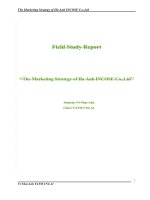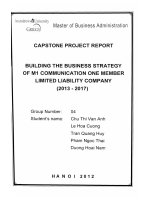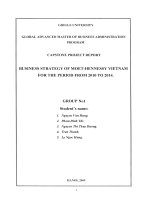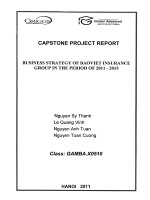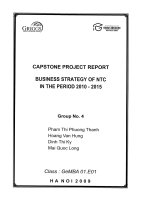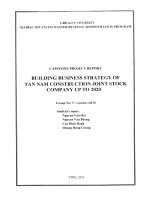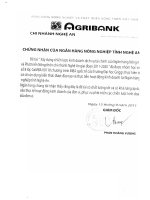Business strategy of Castrol BP Petco co., ltd until 2015
Bạn đang xem bản rút gọn của tài liệu. Xem và tải ngay bản đầy đủ của tài liệu tại đây (1.26 MB, 106 trang )
TRUONG DAI HOC MO TP.HCM UNIVERSITEÙ LIBRE DE BRUXELLES
HO CHI MINH CITY OPEN UNIVERSITY SOLVAY BRUSSELS SCHOOL
MBAVB4
_________________________________________________________________
________
CHU THI MINH HUE
BUSINESS STRATEGY
OF CASTROL BP PETCO CO., LTD.
UNTIL 2015
MASTER PROJECT
MASTER IN BUSINESS ADMINISTRATION
(PART-TIME)
Supervisor: Dr. Nguyen Minh Kieu
Ho Chi Minh City
(2011)
i
ACKNOWLEGEMENT
It is said that “when drinking water, remember its source”. I owe so many
people for their kind support to my thesis and for all knowledges, experiences that
I have gained from the MBA course.
In the first place, I would like to record my gratitude to Prof. Dr. Nguyen Minh Kieu
for his supervision, advices and guidance from the very early stage of this thesis.
He has given me an unflinching encouragement and support in various ways. I am
indebted to him more than he knows.
The thesis would not be written without knowledge that I have gained from the
MBA course especially from strategy subject. I would like to take this opportunity to
say thank you to Prof. Georges Wanet who taught me valuable knowledge of
strategy subject and thank you to all other professors from MBA course. I also
would like to say thank you to Prof. Tuan, Mr. Serge, Ms. Tran, Ms. Ha and Ms.
Hien for their enthusiasm in giving us the best guidelines, support and
arrangement from the course beginning till the accomplishment time.
I gratefully acknowledge Mr. Ta Dinh Quang – Technical Manager of CBP, my
mentor, my colleague for his enthusiasm in providing me useful knowledge about
lubricant technology, sharing me his valuable experiences and giving me good
consultations for my thesis. Thank you all my other good colleagues at CBP and
friends who spent time being interviewed by me and providing me all necessary
information serving my thesis.
Last but not least, I would like to express my great gratefulness to my family and
my beloved relatives for their great encouragement and endless love so that I can
well complete the MBA course today.
ii
DECLARATION
This is to confirm that this thesis for MBA program is my original work. All data and
information come from my survey and study. I am confident to submit this thesis to
the professors of the MBA program. The work was done under the guidance of
Prof. Dr. Nguyen Minh Kieu, under the framework of the Master Program in
Business Management – The Joined Master Program between Ho Chi Minh City
Open University (Vietnam) and Solvay Brussels School (Belgium).
The work was completed in Nov 2011, in Ho Chi Minh City, Viet Nam.
(Student’s name and signature)
Chu Thi Minh Hue
Tutor’s confirmation:
In my capacity as supervisor of the candidate’s thesis, I certify that the above
statements are true to the best of my knowledge and this thesis is well completed
and satisfied with the requirements of MBA thesis.
(Tutor’s name and signature)
Prof. Dr. Nguyen Minh Kieu
iii
TABLE OF CONTENTS
Acknowledgement i
Declaration ii
Table of contents iii
List of tables vii
List of figures viii
List of abbreviations x
Abstract xi
Chapter 1:
INTRODUCTION TO THE STUDY 1
1.1 Rationale of the study 1
1.2 Problem statement 2
1.3 Research objectives and questions 2
1.3.1 Research objectives 2
1.3.2 Research questions 3
1.4 Scope and Limitations 3
1.5 Research method 3
1.6 Structure of the study 4
1.7 Framework of the research study 5
Chapter 2:
LITERATURE REVIEW 7
2.1 Strategy definition and its components 7
2.1.1 Strategy definition 7
2.1.2 Strategy components 9
2.2 The strategy hierarchy 10
2.2.1 Corporate strategy 10
2.2.2 Business strategy 10
2.2.3 Functional strategy 11
2.3 Strategy planning process 11
2.3.1 Mission and vision 12
2.3.2 Environmental analysis 13
iv
2.3.3 Strategy formulation 13
2.3.4 Strategy implementation 14
2.3.5 Strategy evaluation and control 14
2.4 PEST framework 15
2.5 Porter’s five forces model 17
2.5.1 Rivalry among competing firms 18
2.5.2 Threat Of Substitutes 20
2.5.3 Buyer Power 21
2.5.4 Supplier Power 22
2.5.5. Barriers to Entry / Threat of Entry 22
2.6 SWOT framework 25
2.6.1 SWOT Analysis Framework 25
2.6.1.1 Strengths 25
2.6.1.2 Weaknesses 26
2.6.1.3 Opportunities 26
2.6.1.4 Threats 27
2.6.2 The SWOT Matrix 27
2.6.3 SWOT / TOWS Matrix 27
Chapter 3:
ANALYSIS OF EXTERNAL ENVIROMENT 29
3.1 Introduction on lubricant industry in Vietnam 29
3.1.1 Lubricant market overview 29
3.1.2 Supply and demand balance 31
3.1.3 Recent trend 31
3.1.4 Transport segment 34
3.1.5 Competitive environment 36
3.2 Environment analysis (Macro analysis) 36
3.2.1 Political (including legal) factors 37
3.2.1.1 Political stability 37
3.2.1.2 Tax policies 37
3.2.1.3 Environmental regulation 38
3.2.2 Economic factors 39
v
3.2.2.1 Economic growth 39
3.2.2.2 Inflation 40
3.2.2.3 Exchange rate 41
3.2.3 Social factors 43
3.2.3.1 Demography 43
3.2.3.2 Health consciousness 43
3.2.4 Technology 43
3.2.5 Global trend 43
3.3 Industry competitiveness and competitor’s analysis 44
3.3.1 Barrier to entry 44
3.3.2 Power of buyer 45
3.3.3 Threat of substitutes 45
3.3.4 Power of suppliers 46
3.3.5 Rivalry & competitor analysis 47
3.4 Summary of context / external analysis 55
Chapter 4:
ANALYSIS OF CBP INTERNAL ENVIRONMENT 58
4.1 Company’s profile 58
4.1.1 Introduction of BP Global Group 58
4.1.2 Introduction of Castrol BP Petco Co., Ltd 59
4.2 Organization structures 61
4.2.1 Organization chart 61
4.2.2 Organization management and HR policies 62
4.3 Business operation 65
4.3.1 Market segmentation and customers 65
4.3.2 Products 67
4.3.3 Distribution channels 68
4.3.4 Business performance analysis 68
4.3.4.1 Annual sales records 68
4.3.4.2 Castrol BP Petco capability and core competencies 71
4.4 Castrol BP Petco strengths and weakness 75
4.5 SWOT analysis 77
vi
Chapter 5:
PROPOSED BUSINESS STRATEGY OF CBP UNTIL 2015 80
5.1 Castrol BP Petco’s vision and mission 80
5.2 Objectives of CBP strategy until 2015 80
5.3 Strategy in actions 81
5.3.1 Business strategy alternatives initiatives base on SWOT analysis 81
5.3.1.1 S-O strategy 81
5.3.1.2 S-T strategy 82
5.3.1.3 W-O strategy 82
5.3.1.4 W-T strategy 83
5.3.2 Business strategy choice 83
5.4 Strategy implementation 85
5.5 Sales forecast by market space until 2015 88
CONCLUSIONS AND RECOMMENDATION 90
References I
List of support and interview persons III
Some interview questions V
LIST OF TABLES
Table name
Page
Table 2.1 PEST analysis factors 16
Table 2.2 Buyer Power 21
Table 2.3 Supplier Power 22
Table 2.4 Entry and Exit Barriers 24
Table 2.5 SWOT Analysis Framework 25
Table 2.6 SWOT / TOWS Matrix 27
Table 3.1 Selected major lubricant blending plants in Viet Nam 30
Table 3.2 Evolution of lubricant demand 33
Table 3.3 Demand for transport Oil – Vietnam 34
vii
Table 3.4 Demand for Non- transport Lubricants – Vietnam 35
Table 3.5 Estimated lubricant Sales and Market Shares – Vietnam 48
Table 3.6 Profiles of all lubricant operators in Viet Nam 51
Table 4.1 Some main Castrol, BP products 67
Table 5.1 SWOT analysis 77
viii
LIST OF FIGURES
Figure name
Page
Figure 1.1 Framework of the research study 5
Figure 2.1 Critical dimensions of strategy 8
Figure 2.2 The strategic planning process 12
Figure 2.3 Porter’s Five Forces Model 17
Figure 3.1 Lubricant demand by category 32
Figure 3.2 Evolution of lubricant demand 32
Figure 3.3 Motor Oil Intensity Factor 34
Figure 3.4 Industrial Oil Intensity Factor 34
Figure 3.5
Transport segment Demand 35
Figure 3.6 Demand Growth – Transportation Oil vs Motor Fuels 35
Figure 3.7 Demand for Non- transport Lubricants Vietnam 36
Figure 3.8 Real GDP Growth & per Capital 40
Figure 3.9 Unemployment & inflation 40
Figure 3.10 Exchange rate UD Dollars (D/$) 41
Figure 3.11 Main lubricant CBP suppliers 46
Figure 3.12 Lubricant Market Shares in Vietnam (2009) 47
Figure 3.13 Transport and Non-Transport segment market shares 49
Figure 4.1 BP global picture 58
Figure 4.2 Nha Be Plant picture 60
Figure 4.3 Organization chart of Castrol BP Petco 61
Figure 4.4 CBP Code of conduct 62
Figure 4.5 CBP leadership 63
Figure 4.6 CBP Employee’s benefits 64
Figure 4.7 MCO, PCO, CT Market segmentation and customers 65
Figure 4.8 HD Market segmentation and customers 66
ix
Figure 4.9 OEM Market segmentation and customers 66
Figure 4.10 CBP products 67
Figure 4.11 CBP Sales volume by brand 2006 – 1011 69
Figure 4.12 CBP Sales volume by market space 2006 – 1011 70
Figure 4.13 CBP Sales volume by channel 2006 – 1011 70
Figure 4.14 CBP Sales volume, Gross Turnover, Gross Margin 2006 - 2011 71
Figure 4.15 CBP Key success factors of CBP 74
Figure 5.1 CBP forecast of sales volume by market space until 2015 89
x
LIST OF ABBREVIATIONS
CBP Castrol BP Petco., Ltd
ASEAN Association of South East Asian Nations
WTO World Trade Organization
VIP Very Important Person
MES Minimum Efficient Scale
GDP Gross Domestic Product
TOWS Threats Opportunities Weaknesses Strengths
SWOT Strength – Weakness – Opportunities - Threats
PEST Political, Economic, Social, and Technological analysis
LEP Law on the Protection of the Environment
MOSTE Ministry of Science, Technology and the Environment
DPI Department of Planning and Investment
MCO Motorcycle Oil
PCO Passenger Car Oil
CT Consumer Truck
OEM Original Equipment Manufacturers
HD Heavy Duty
DIFM Do-It-For-Me
SAE Society of Automotive Engineers
B2B Business To Business
B2C Business To Consumer
MPI Ministry of Planning and Investment
ISO International Organization for Standardization
OHSAS Occupational Health And Safety Assessment System
KPI Key Performance Index
VPP Variable Pay Plans
OMS Operating Management System
WCSC World Class Sales Call
WCCM World Class Customer Management
Kt/y Kilo ton / year
xi
ABSTRACT
Vietnam, Southeast Asia’s fourth-largest lubricants market, saw its total inland
demand for lubricants in these recent years. Promising to become a potential
economic industry, lubricant business has many good opportunities and strengths
to be developed thanks to the advantages of the economic context, the
development of transportation and other industries in which lubricant plays an
important role. There are more and more lubricant operators including local
enterprises and foreign companies have entered this field making lubricant market
become a fierce competition than ever.
Among lubricant players in Viet Nam, Castrol BP Petco (CBP) , a join-venture
company between British Petroleum (BP) and Petrolimex, is the market Leader
operating the country’s largest blending plant with the capacity of 70 kt/year. CBP
has a wide distribution network with hundreds Distributors and Dealers and
thousands customers on the nationwide. With strong heritage of the two global
leading brands and premium products and with valuable experience in lubricant
business, CBP proves its success through great business results in continuous
years. Nevertheless, besides the success, still there are some issues on the
investment policies and business orientation that limited CBP development in the
last few years. Therefore, how to solve these issues as well as to build an
appropriate strategy for CBP in order to keep its number 1 position in the market
and to develop business is the big questions for CBP strategists.
It’s is said that “If we know where we are and something about how we got
there, we might see where we are trending and if the outcomes which lie
naturally in our course are unacceptable, to make timely change” – by
Abraham Lincoln. By analyzing thoroughly external environment with macro and
micro factors on the lubricant market as well as assessing internal factors of CBP,
an appropriate strategy until 2015 has been formed with details plan of
implementation base on the opportunities and strengths after considering the
threats and company’s weakness. By gaining competitive advantages,
differentiating and strengthening Castrol & BP brands, focusing on the high quality
xii
product and enhancing long term customer loyalty through innovative offers, a
bright and successful future of CBP can be predicted from today.
The study has been made by using secondary data, study and internal materials
provided by CBP and from other reliable sources with consultation, advices and
desk interview with Management Team, colleagues of CBP. Last but not least, the
success of this study thanks to the strategy knowledge provided in the MBA
Course and with references from useful strategic management book of Fred David
and others.
- 1 -
Chapter 1
INTRODUCTION TO THE STUDY
1.1 RATIONALE OF THE STUDY:
Lubricant market has been developing strongly in these recent years together with
the development of transportations and other industries. The vehicle fleet in
Vietnam continues to expand, growing by some 11.3% in 2009, to a total of some
24.4 million units at year-end; the passenger car equipment rate remains among
the lowest in the world, with motorcycles accounting for 93% of the country’s total
fleet. Assuming continued robust growth in the country’s vehicle fleet, its broader
economy, and its industrial production, Vietnam’s lubricants demand is projected
to rise at some 4.1% per year on average through 2014, to 378 kt. With all of
these advantages, there is a promise of an optimistic picture for all lubricant
operators in Viet Nam.
Castrol BP Petco Co., Ltd (CBP) is a 65:35 joint venture between BP and
Petrolimex, operating Vietnam’s largest blending plant with semi-automated filling
lines and a testing laboratory. Base on the merge and acquisition between the two
leading lubricant companies: BP Petco Ltd. (since 1992) and Castrol Viet Nam Ltd.
(since 1991), CBP is now is now the leading lubricant marketer in Vietnam
inheriting the two global famous brands of Castrol and BP with the highest market
share of 27%.
Beside certain success in continuous years, CBP in Viet Nam still have to face
some issues that limit the development of the company. As a multinational
company, managed and directed by the region, every activity made by CBP
should have approval from and sometimes has been imposed by the region.
Following this, some policies and decision imposed by the region are not
appropriate with Viet Nam country. On one side, CBP Board of Directors are trying
to comply with but on the other hand, they are trying to harmonize business
strategy to be appropriate with Vietnam environment base on the external and
internal context in order to compete with other competitors.
- 2 -
Building an appropriate strategy for CBP from now to 2015 with clear objectives
and vision is our purpose and the rational of the study in order to help CBP
Management Board to have a right business direction to keep number 1 position
in the market as expected.
1.2 PROBLEM STATEMENT:
Having significant success in the continuous years with average volume growth
rate of 10% and 20% growth in gross margin versus previous year, CBP has
proved strong and leading position in the lubricant market. Nevertheless, as a
multinational company under direct management from the region, CBP in Viet
Nam is now facing some problems in term of strategy management imposed by
the region that is not appropriate with Viet Nam. As the consequence, there is still
some limitation for CBP in developing the market. If these problems are not
solved, CBP might have difficulties in the fierce competition with many young and
strong competitors.
By analyzing thoroughly external environment with macro and micro factors on the
lubricant market as well as assessing internal factors of CBP, an appropriate
strategy for CBP in Viet Nam until 2015 has been formed with details plan of
implementation base on the opportunities and strengths after considering the
threat and company’s weakness. By gaining competitive advantages,
differentiating and strengthening Castrol & BP brands, focusing on the high quality
product and enhancing long term customer loyalty through innovative offers, the
strategy of CBP is very feasible and optimistic to be successful.
1.3 RESEARCH OBJECTIVES AND QUESTIONS:
1.3.1 Research objectives:
This thesis objective is to build up an appropriate business strategy for CBP
Vietnam to implement during the period 2012 to 2015. The study will apply
theories of strategy management, external and internal environment analysis,
SWOT analysis, competitive strategy by Michael Porter and use secondary data
to develop the business strategy for CBP Viet Nam until 2015.
- 3 -
1.3.2 Research questions:
There are 3 big questions for this study, those are:
• What are the issues of CBP in term of business management and orientation?
• What are the external and internal factors influencing CBP business?
• How to build an appropriate business strategy for CBP in Vietnam until 2015?
1.4 SCOPE AND LIMITATIONS
The study focuses on analyzing internal factors of CBP and assessing external
context environment and lubricant market in Viet Nam. All the internal factors are
coming from overall aspects of the company in term of sales, marketing, finance,
distribution and customer services with SWOT analysis method. For external
factors, the study used PETS theory to analyze the politics, economy, technology
and society. The study also applied strategic management theories and its
literature review combining with the use of secondary data, desk interview and
other information from reliable resources to write this thesis. The thesis, therefore,
is about how to build an appropriate business strategy for CBP in Viet Nam for the
near future from 2012 to 2015 base on the situational analysis.
1.5 RESEARCH METHOD:
The study has been made by applying some research methods such as using
secondary data from CBP internal sources and other reliable reference books,
magazines, articles from internets. Besides, in order to reflect the honesty as well
as the quality of the study, a qualitative method has been used by having an
interview with some VIP of CBP and others with many open questions for them.
By doing this way, many good and interesting ideas, points of view have been
shared by CBP mentor, colleagues and others contributing to the success of this
thesis.
The study is also applied the theories and frameworks of SWOT, Porter Five
Forces model, PEST from many famous authors in the world.
- 4 -
1.6 STRUCTURE OF THE STUDY:
The study is organized into 6 chapters as follows:
Chapter 1: Introduction to the study
This is the preliminary chapter, which provides the rational of the study, problem
statement, research objectives and questions, scope and limitations, research
method and structure of the study.
Chapter 2: Literature Review:
This chapter covers literature referring to this study including theory about strategy
management: strategy and its components, strategy hierarchy, strategy planning
process with external and internal analysis, strategy in action and choice. The
study also applies theory of PEST framework, Porter’s five forces model and
SWOT framework in order to achieve the objectives of the study.
Chapter 3: Analysis of external environment
This chapter focuses on analyzing the external factors influencing the business of
CBP. The context analysis is made with macro factors about political, economic,
social, technological issues and global trend. Lubricant industry environment and
market are also reviewed and assessed to find out what are the opportunities and
threats to the company.
Chapter 4: Analysis of external environment
This chapter focuses on analyzing all internal factors of Castrol BP Petco itself to
define what are the strengths and weaknesses of the company preparing for the
next steps of building the strategy for Castrol BP Petco.
Chapter 5: Proposed business strategy of CBP until 2015 and strategy
implementation
Base on the analysis mentioned in Chapter 3, Chapter 4 comes up with several
strategic alternatives after defining the business vision and mission as well as long
term objectives of the companies. An appropriate strategy until 2015 is
recommended for Castrol BP Petco.
- 5 -
Objectives and strategy will not be achieved without specific actions and
implementation. This Chapter also helps to bring theory into reality by building
specific action plans for implementation of the proposed business strategy.
Conclusions
This section summarizes the previous chapters and evaluates the proposed
business strategy and its action plan.
1.7 FRAMEWORK OF THE RESEARCH STUDY:
Figure 1.1 - Framework of the research study
The above Figure 1.1 illustrated the framework of this study. This study will begin
with the review of literature which concerns the strategic management process,
particularly the process of strategy formulation. It also mentions to the concepts
and principles of Porter’s model to analyze the competitive environment of the
industry.
- 6 -
Chapter 2
LITERATURE REVIEW
2.1 STRATEGY DEFINITION AND ITS COMPONENTS:
2.1.1 Strategy definition:
Havard’s Chandler (1962) defined strategy as “the determination of the basic long
term goals and objectives of an enterprise, and the adoption of course of action
and the allocation of resources necessary for carrying out the goals”. Implicit in
Chandler’s definition is the idea that strategy involves a rational planning process.
The organization is depicted as choosing its goals, identifying the courses of
action (or strategy” that best enable it to fulfill its goals, and allocating resources
accordingly (Hill/Jones, 1989). Similarly, B.Quinn of Darthmouth College (1980)
has defined strategy as “the pattern or plan that integrates an organization’s major
goals, policies and action sequences into cohesive whole”. And along the same
line, F.Glueck defined strategy as “a unified, comprehensive and integrated plan
designed to ensure that the basic objectives of the enterprise are achieved”.
However, planning-based definitions of strategy have evoked criticism for all their
appeal. As pointed out by Mintzberg, the planning approach incorrectly assumes
that an organization’s strategy is always the outcome of rational planning, while it
ignores the fact that strategies can emerge from within an organization without
any formal plan. Mintzberg defined strategy as “a pattern in a stream of decision
or actions”. The pattern being a product of whatever intended strategies (planned)
are actually realized and of any emergent (unplanned) strategies. Based on that, a
summary of the definition offered by many authors “a strategy is a fundamental
pattern of present and planned objective resources deployments and interactions
of an organization with market, competitors and other environmental factors” gives
the sufficient definition of strategy. Strategy is not only to do with the marketing of
the activities of an organization to the environment in which it operates and to its
resource capability, but also will be effected by the values and expectations of
those who have power in the organization.
- 7 -
Overall, if a definition of strategy is required, these characteristics can provide a
basis for one. Strategy is the direction and scope of an organization over the long
term, which achieves advantage for the organization through its configuration of
resources within a changing environment, to meet the needs of markets and fulfill
stakeholder expectations.
In short, reviewing some of the most important work in the field of strategy, the
critical dimensions that contribute to the unified definition of the concept of
strategy have been identified by Hax and Majluf (1991) as following (Figure 2.1).
Figure 2.1 - Critical dimensions of strategy
Source: Hax and Mailuf, 1991
2.1.2 Strategy components:
In concrete, there are five components or sets of issues in a well developed
strategy:
- 8 -
- Goals and objectives: Strategies should specify desired levels of
accomplishment on one or more dimensions of performance such as volume
growth, profit contribution or return on investment over specified time periods
for each of the firm’s businesses and product-markets and for the organization
as a whole.
- Scope: The scope of an organization refers to the breadth of its strategic
domain: The number and types of industries, product lines and market
segments it completes in or plans to enter. Decisions about an organization’s
strategic scope should reflect management’s view of the firm’s mission or
strategic intent.
Resource deployments: Every organization has limited financial and human
resources. Therefore, a strategy should specify how such resources are to be
obtained and allocated across business, product-markets, functional
departments or management teams and activities within each business or
product market.
- Identification of a sustainable competitive advantage: Perhaps the most
important part of any strategy is a specification of how the organization will
complete in each business and product-market within its domain. How can it
position itself to develop and sustain a differential advantage over current and
potential competitors? To answer such questions, managers must examine the
market opportunities in each business and product-market and the company’s
core competencies or strengths relative to it competitors.
- Synergy: Synergy exists when the firm’s businesses, product-markets,
resource deployments and competencies complement and reinforce one
another. Synergy enables the total performance of related business to be
greater than it would otherwise be: The whole become greater than the sum of
its part. Consequently, strategies should be designed to exploit potential
sources of synergy across the firm’s businesses and product markets as a
means of improving the organization’s overall efficiency and effectiveness.
- 9 -
2.2 THE STRATEGY HIERARCHY:
Instead of a single comprehensive strategy, most organizations pursue a
hierarchy of interrelated strategies, each formulated at a different level of the firm.
The three major levels of strategy in most large, multi-product organizations are
as below:
2.2.1 Corporate strategy:
At the corporate level, managers must coordinate the activities of multiple
business units. Thus, decisions about the organization’s scope and appropriate
resource deployments across its various divisions or businesses are the primary
focus of corporate strategy:
Attempts to develop and maintain distinctive competencies at the corporate level
tend to focus on generating superior financial, capital and human resources;
designing effective organization structures and processes; and seeking synergy
among the firm’s various businesses. Synergy can become a major competitive
advantage in firms where related businesses reinforce one another by sharing
corporate staff, R&D, financial resources, production technologies, distribution
channel or marketing programs.
2.2.2 Business strategy:
Business strategy or competitive strategy refers to the plan of actions that
management adopts to use a company’s resource and its distinctive ability to gain
a competitive advantage over its rivals in a market or industry. Porter (1985)
proposed three generic strategies that company can pursuit to outperformance its
competitors in the market as below:
- Low cost strategy, strategy to design, produce and market a comparable
product more efficiently and thus cheaper than its competitors do. Cost
leadership strategy aims at the mass market and require aggressive
construction of how cost structure including efficient scale facilities, vigorous
pursuit of cost reduction, tight control of overhead cost and cost minimization
in areas like R&D, service, sales fore, advertising and so on. Low cost
- 10 -
structure allows company to charge lower price and thus allow company to
compete when fierce competition exist with a quite reasonable good profit.
- Differentiation strategy refers to strategy to deliver uniqueness and superior
value to buyers in term of product quality, special feature, or after sales
services. Differentiation focus also at the broad market and involves the
creation of a product or service that is perceived through the industry as
unique. Unique product enables firms to charge higher price for its product.
The specialty can come from brand image, technology, features or dealer
network. Differentiation is viable for above-average profit. The research of
Caves and Ghemawat shows that differentiation generates high profit than low
cost strategy because it creates higher entry barrier.
- Focus strategy can be cost focus or differentiation focus. This strategy
focuses to serve only specific needs of market segment. Usually, this strategy
is pursuit by small company to a market niche while mass market has been
well dominated by other large companies.
2.2.3 Functional strategy
It is a plan of actions to strengthen an organization’s functional and organizational
resources as well as its coordination abilities in order to create core competence.
2.3 STRATEGY PLANNING PROCESS:
In the current fierce competitive environment, budget-orientated planning or
forecasted-based planning methods are insufficient for a large firm to survive and
to be wealthy. A strategy planning process is necessary for the firm from the first
step of defining objectives, assessing both internal and external situation in order
to formulate strategy, implement the strategy, evaluate the progress and make a
necessary adjustment to stay on track.
- 11 -
Source:
www.quickmba.com/strategy/strategy-planning,
(1999-2000) Internet Center for
Management and Business Administration, Inc.
2.3.1 Mission and vision
Defining by Janmes C. Collins and Jerry I. Porras (2000), the mission statement
describes the company’s business vision, including the unchanging values and
purpose of the firm and forward-looking visionary goals that guide the pursuit of
future opportunities.
Instructed by the business vision, the firm’s leaders can define measurable
financial and strategic objectives. Financial objectives involve measures such as
sales targets and earning growth. Strategic objectives are related to the firm’s
business position and may include measures such as market share and
reputation.
Figure 2.2 :The strategic planning process
- 12 -
2.3.2 Environmental analysis:
According to David A.Aaker (1995), the environmental analysis includes three
components such as External analysis, Industry environment analysis and internal
analysis of the firm.
The internal analysis helps to identify the firm’s strengths and weaknesses. Those
are organization’s controllable activities arising in management, marketing,
finance/ accounting, production/operations, research and development and
management information system activities of a business. Identifying and
evaluating organizational strengths and weaknesses in the functional areas of a
business is an essential strategies management activity. Organizations strive to
pursue strategies that capitalize on internal strengths and eliminate internal
weaknesses.
Meanwhile, the external analysis reveals opportunities and threats with a overview
evaluation on economic, social, cultural, demographic, environmental, political,
legal, governmental, technological (PEST framework) and competitive trends and
events that could significantly benefit or harm an organization in the future
Opportunities and threats area largely beyond the control of a single organization,
thus the word external.
A profile of the strengths, weaknesses, opportunities and threats is generated by
SWOT analysis.
An industry analysis can be performed using a framework developed by Michael
Porter known as Porter’s five forces. This framework evaluates entry barriers,
suppliers, customers, substitute products and industry rivalry.
2.3.3 Strategy formulation:
Strategy formulation includes developing vision and mission, identifying an
organization’s external opportunities and threats, determining internal strengths
and weaknesses, establishing long-term objectives, alternating strategies and
choosing particular strategies to pursue. Strategy formulation issues include
deciding what new business to enter, what businesses to abandon, how to
allocate resources, whether to expand operations or diversify, to merge of form
